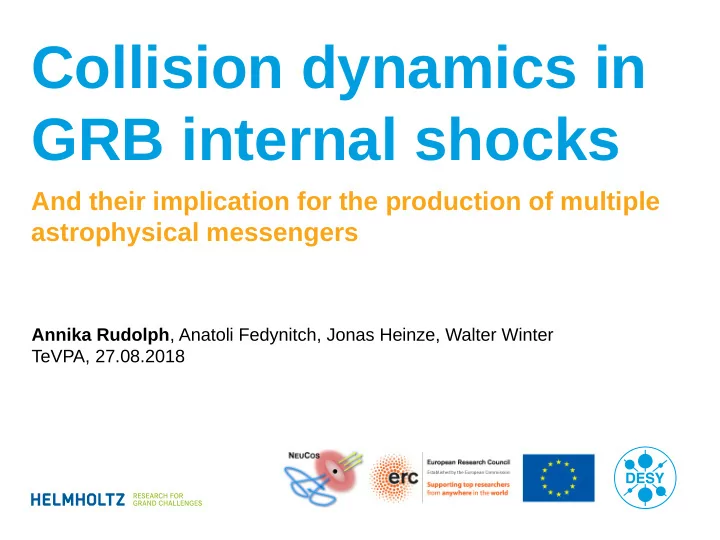

Collision dynamics in GRB internal shocks And their implication for the production of multiple astrophysical messengers Annika Rudolph , Anatoli Fedynitch, Jonas Heinze, Walter Winter TeVPA, 27.08.2018
Common origin of UHECR and HE neutrinos Interactions of UHECR in the sources → secondary neutrinos Neutrinos: no deflection due to magnetic fields, (almost) no interactions → point back to sources ν γ Cosmic Rays Detection of UHECR, gammas and neutrinos on earth Annika Rudolph | Collision dynamics in GRB internal shocks | TeVPA 2018 Page 2
Neutrino constraints on UHECR sources Ahlers, Halzen, Prog.Part.Nucl.Phys. 102 (2018) Aartsen et al. 73-88 Astrophys. J, 843, 112 (2017) Search for coincidence between IceCube neutrinos and high-energy photon detections constrain UHECR sources: Aartsen et al, Astrophys. J, Limits on the neutrino flux from AGNs ● 835, 45 (2017) Lack of neutrinos from detected Gamma-Ray ● Bursts rule out the most simple GRB Abbasi et al, Nature 484: 351-353 (2012) scenarios as sources of UHECR Annika Rudolph | Collision dynamics in GRB internal shocks | TeVPA 2018 Page 3
What are Gamma-Ray Bursts? Prompt emission GRB characteristics Luminosities: ▸ 10 49 - 10 53 ergs / s Duration: ▸ 0.1 – 100 s Progenitors: ▸ Daniel Perley sGRB (0.1 – 1 s) → Merger of 2 compact Objects lGRBs (10 – 100 s) → Collapse of massive stars Redshifts: 1-3 ▸ Multiwavelength afterglow lasting up to ▸ months Barat et al, 2000, ApJ 538(1):152 Annika Rudolph | Collision dynamics in GRB internal shocks | TeVPA 2018 Page 4
Fireball-internal shock model θ Г ~ 200 - 500 Source: NASA Annika Rudolph | Collision dynamics in GRB internal shocks | TeVPA 2018 Page 5
Fireball-internal shock model Multi-Collision model Stochasticity of light curve due to stochasticity of source → explain large variety of observed light curves Source: NASA Annika Rudolph | Collision dynamics in GRB internal shocks | TeVPA 2018 Page 6
Spatial resolution of fireball properties and particle production Energy dissipation within the fireball Energy in different particle species See Bustamante, Heinze, Murase, Winter, Distance from engine Astrophys. J., 837, 33 (2017) V shell ⍺ R 2 → large collision radii = low densities (particles, photon fields, magnetic fields) Annika Rudolph | Collision dynamics in GRB internal shocks | TeVPA 2018 Page 7
Spatial resolution of fireball properties and particle production Energy dissipation within the fireball Energy in different particle species Distance from engine V shell ⍺ R 2 → large collision radii = low densities (particles, photon fields, magnetic fields) Annika Rudolph | Collision dynamics in GRB internal shocks | TeVPA 2018 Page 8
Spatial resolution of fireball properties and particle production Energy dissipation within the fireball Energy in different particle species Distance from engine V shell ⍺ R 2 → large collision radii = low densities (particles, photon fields, magnetic fields) Annika Rudolph | Collision dynamics in GRB internal shocks | TeVPA 2018 Page 9
Spatial resolution of fireball properties and particle production Energy dissipation within the fireball Energy in different particle species Distance from engine V shell ⍺ R 2 → large collision radii = low densities (particles, photon fields, magnetic fields) Annika Rudolph | Collision dynamics in GRB internal shocks | TeVPA 2018 Page 10
Alternative collision models Ultraefficient shock scenario Kobayashi, S. & Sari R. 2001, Astrophys. J., 551, 934 (KS’01) Motivation: Problems in the standard merging shell scenario 1. Low efficiency in converting fireball kinetic energy into radiation → bright afterglow / photospheric emission? (not compatible with observations) 2. High variability in the light curve requires highly variable central source Possible solution: alternative collision dynamics (ultraefficient shock scenario) → intrinsically solves both problems Annika Rudolph | Collision dynamics in GRB internal shocks | TeVPA 2018 Page 11
Analysing ultraefficient shocks with hydrodynamic simulations Each collision is a hydrodynamic process Kino et al, Astrophys. J. 611: 1021-1032 (2004) → Set up 1D RHD simulation to analyse collision process with PLUTO http://plutocode.ph.unito.it/ Results: 1. Ultraefficient shock scenario realistic for shells with comparable masses and high spread in Lorentz factor 2. Non-thermal energy dissipation decrease the probability for ultraeff. shocks 3. In complete fireball simulation (const mass outflow), only ~10 % of the collisions → Ultraefficient shock scenario only possible under very specific conditions Annika Rudolph | Collision dynamics in GRB internal shocks | TeVPA 2018 Page 12
Fireball properties in the ultraefficient shock scenario Energy dissipation within the fireball Energy in different particle species Distance from engine Annika Rudolph | Collision dynamics in GRB internal shocks | TeVPA 2018 Page 13
Impact on observables For the same luminosity, light curve variability and duration 1) Neutrino Flux : Slightly reduced in ultraefficient shock scenario (model B) 2) Light curve : Few collisions with high energies dominate the light curve → more structure Annika Rudolph | Collision dynamics in GRB internal shocks | TeVPA 2018 Page 14
Summary and conclusion Multi-Collision model • Allows to identify production regions of different particle species Ultraefficient shock scenario • Intrinsically high efficiency and less source variability required • Neutrino Fluxes comparable, light curves slightly different Hydrodynamic simulations • Validation of collision process model • Standard merging-shell scenario is usually a good approximation • Ultraefficient shock scenario only applicable under very specific conditions Annika Rudolph | Collision dynamics in GRB internal shocks | TeVPA 2018 Page 15
Backup
Impact of energy dissipation / 2-shell parameter space No energy dissipation 50% of Eint into non-thermal in PLUTO particles Page 17 Annika Rudolph | Collision dynamics in GRB internal shocks | TeVPA 2018
Fireball evolution (constant power outflow) Page 18 Annika Rudolph | Collision dynamics in GRB internal shocks | TeVPA 2018
Recommend
More recommend